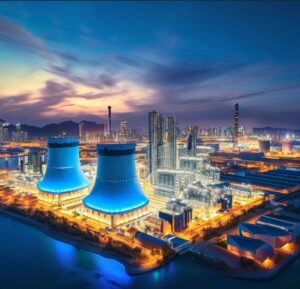What are the largest commercial uses of electricity?

Unveiling the Largest Commercial Uses of Electricity
Electricity is a vital resource for commercial establishments, powering a wide array of operations and processes. In this article, we will explore the largest commercial uses of electricity, shedding light on the industries and sectors that have the highest electricity demands. Additionally, we will introduce Bid On Energy, a platform that can help businesses optimize their commercial electricity costs. By leveraging Bid On Energy's services, commercial enterprises can find competitive electricity rates and achieve significant savings on their energy consumption.
Manufacturing Sector:
The manufacturing sector stands as one of the largest consumers of electricity. Industries such as automotive, electronics, chemical, and food processing rely heavily on electricity to power machinery, assembly lines, and various production processes. From operating heavy machinery to running conveyor belts and powering industrial ovens, electricity is integral to the manufacturing sector's daily operations.
Commercial Buildings:
Commercial buildings, including offices, retail spaces, and hotels, have substantial electricity demands. Lighting, heating, ventilation, and air conditioning (HVAC) systems, elevators, escalators, security systems, and computer networks all require electricity to function efficiently. As the number of commercial buildings continues to grow, so does their collective electricity consumption.
Healthcare Facilities:
Hospitals, clinics, and healthcare facilities have significant electricity needs due to their 24/7 operation and the use of high-tech medical equipment. Medical imaging devices, life support systems, diagnostic equipment, lighting, and HVAC systems all rely on electricity to provide quality healthcare services. Ensuring reliable and uninterrupted power supply is crucial in healthcare settings.
Data Centers:
With the rapid growth of the digital age, data centers have become essential for storing, processing, and transmitting vast amounts of information. These facilities require enormous amounts of electricity to power servers, cooling systems, backup generators, and networking equipment. As the demand for data storage and cloud computing increases, so does the electricity consumption of data centers.
Educational Institutions:
Schools, colleges, and universities are significant consumers of electricity. Classroom lighting, air conditioning, computer labs, audiovisual equipment, and research facilities all contribute to the electricity needs of educational institutions. As educational technology advances and campuses expand, the demand for electricity in this sector continues to rise.
Hospitality and Tourism:
Hotels, resorts, and other hospitality establishments rely on electricity for various purposes, including guest room amenities, heating and cooling systems, lighting, elevators, kitchens, and laundry facilities. With the continuous flow of guests and the need for comfort and convenience, electricity consumption in the hospitality industry is substantial.
Food and Beverage Industry:
Restaurants, cafes, bakeries, and food processing plants require electricity to power kitchen appliances, refrigeration units, ovens, grills, ventilation systems, and lighting. The food and beverage industry has extensive electricity needs to maintain food safety, meet production demands, and provide an inviting dining experience.
Retail Sector:
Retail businesses, including supermarkets, department stores, and shopping centers, consume significant amounts of electricity to power lighting, air conditioning, heating, point-of-sale systems, refrigeration units, and security systems. With large floor areas and constant foot traffic, retail establishments require reliable and efficient electrical infrastructure.
Entertainment and Leisure Facilities:
Amusement parks, casinos, theaters, sports arenas, and concert venues have substantial electricity requirements. Lighting systems, sound equipment, air conditioning, rides, gaming machines, and large-scale displays all rely on electricity to create immersive experiences for visitors.
Transportation Infrastructure:
Airports, train stations, ports, and logistics centers consume substantial amounts of electricity to power lighting, HVAC systems, conveyor belts, security systems, ticketing and baggage handling systems, and electric vehicle charging stations. Efficient and reliable electricity supply is essential for the smooth operation of transportation hubs.
Warehousing and Distribution Centers:
Warehouses and distribution centers play a crucial role in the supply chain, requiring electricity for lighting, climate control, conveyor systems, material handling equipment, and inventory management systems. As e-commerce continues to grow, the demand for electricity in this sector rises accordingly.
Financial Institutions:
Banks, financial institutions, and data centers within the financial sector rely heavily on electricity to power computer systems, servers, ATMs, security systems, and backup power infrastructure. Reliable and secure electricity supply is critical to ensure uninterrupted financial services.
By recognizing the largest commercial uses of electricity across these sectors, businesses can better understand their energy needs and identify areas for optimizing energy consumption. Leveraging platforms like Bid On Energy allows commercial enterprises to find competitive electricity rates, select customized energy solutions, and effectively manage their electricity costs to drive savings and improve operational efficiency.
Bid On Energy: Optimizing Commercial Electricity Costs
To effectively manage and reduce commercial electricity expenses, Bid On Energy offers valuable solutions to businesses. Here's how Bid On Energy can assist commercial enterprises:
Competitive Bidding Process:
Bid On Energy connects commercial consumers with multiple electricity suppliers, creating a competitive marketplace. Suppliers compete to offer the most attractive rates, contract terms, and additional benefits. This competition empowers businesses to choose the most cost-effective electricity plans, resulting in significant savings on their energy bills.
Simplified Comparison and Selection:
Bid On Energy simplifies the process of comparing multiple supplier offers. The platform provides a user-friendly interface that enables businesses to evaluate rates, contract lengths, and other key factors. This allows businesses to make informed decisions and select the electricity plan that best fits their financial objectives.
Customized Energy Solutions:
Bid On Energy understands that each commercial enterprise has unique energy requirements. The platform works with a range of suppliers offering customized energy solutions tailored to specific business needs. This includes options such as renewable energy sources, flexible contract terms, and energy efficiency initiatives, providing businesses with greater control over their energy consumption and costs.
Time and Resource Management:
By centralizing supplier options and streamlining the selection process, Bid On Energy saves businesses valuable time and resources. Instead of individually researching and contacting multiple suppliers, businesses can conveniently access all available options through the platform. This allows them to focus on their core operations while maximizing cost savings.
Today the largest commercial users of electricity encompass industries such as manufacturing, commercial buildings, healthcare facilities, data centers, and educational institutions. These sectors have high electricity demands due to their specific operational requirements. To optimize commercial electricity costs, Bid On Energy serves as a valuable resource, offering a competitive bidding process, simplified comparison and selection, customized energy solutions, and efficient time and resource management. By leveraging Bid On Energy's services, businesses can achieve substantial savings on their commercial electricity expenses while focusing on their core operations. Embrace Bid On Energy to unlock cost savings and enhance your overall energy management strategy.
COMPARE COMMERCIAL ENERGY COSTS
LOWER COMMERCIAL UTILITY BILLS

